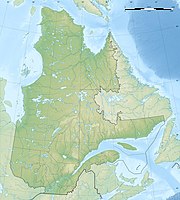Réserve écologique de la Tourbière-de-Shannon
|
Réserve écologique de la Tourbière-de-Shannon
|
||
| location | La Jacques-Cartier , Quebec, Canada | |
| surface | 1.69 km² | |
| WDPA ID | 555569772 | |
| Geographical location | 46 ° 54 ' N , 71 ° 33' W | |
|
|
||
| Setup date | 2011 | |
| administration | MDDEP | |
The Réserve écologique de la Tourbière-de-Shannon is a 168.77 hectare protected area established in 2011 in the south of the Canadian province of Québec in the regional county municipality of La Jacques-Cartier .
It is located about 30 km northwest of Québec in the Capitale-Nationale administrative region in the Shannon parish . In total, the moor covers an area of 250 ha, two thirds of which are under strict protection.
The Shannon Bog Protected Area , in an excellent state of conservation, primarily represents the flora and fauna characteristic of the region's bogs, more precisely the less nutrient-poor bogs of the District écologique des Basses collines du lac Saint-Joseph in the middle Laurentides , the ecological reserve located in the hills around Lac Saint-Joseph . This type of bog is only supplied with water by rain and snow.
With the retreat of the glaciers to the north about 12,500 years ago, the Atlantic penetrated into the area of the lower St. Lawrence River . The Champlain Sea disappeared about 9500 years ago and the current took its current course. Where the Laurentides Mountains and the Champlain Sea collided, the Shannon Moor is now located in the several square kilometer delta of the Jacques Cartier River . Its alluvial soil therefore dominates the region, the actual bog soil is around 30 cm thick. In summer only the rain brings in minerals, in winter the moor is covered with snow and ice.
The soil is quite acidic ( pH 3.5 to 4.6), whereby the acid is also brought in by peat moss . Most of it consists of peatland , but in the west there are post-glacial sand dunes, even if there are mosses. The gray or white alder ( Alnus incana ) of the subspecies Alnus incana ssp. rugosa can often be found on the dunes, which are covered by a layer of organic material up to 15 cm thick, but are often exposed.
The Moose mainly belong to the genera of Polytrichum ( polytricha ) and the Dicranaceae . Ferns do not exist in the bog.
Two endangered orchid species occur in the Shannon Moor, namely the Platanthera blephariglottis var. Blephariglottis , known there as Platanthère à gorge frangée , and the listère australe or Listera australis . The former belongs to the genus of forest hyacinths , the latter to the genus two-leaf . About a thousand specimens have been counted from the forest hyacinth species. About 500 of the two-leaf were registered, making this location the second largest in the province. The Listera were named after the English naturalist and doctor Martin Lister (1638-1712). It prefers locations protected by trees or bushes, especially those that face south.
Otherwise, it is found from the family of heather plants Kalmia polifolia and Kalmia angustifolia of the genus Kalmia , then chamaedaphne ( Chamaedaphne calyculata ) and Bog Labrador Tea ( Rhododendron groenlandicum ), from the family of Cyperaceae especially Carex oligosperma from the kind of sedges , Eriophorum virginicum from the genus of cottongrass , which also includes vaginal cottongrass ( Eriophorum vaginatum ) and narrow-leaved cottongrass ( Eriophorum angustifolium ). Black spruce ( Picea mariana ) and East American larch ( Larix laricina ) are found on trees .

The fauna is still largely unexplored. The beaver can be recognized by the dams, black bears , moose and white-tailed deer have been spotted . Fish include brook trout ( Salvelinus fontinalis ), Semotilus atromaculatus , also called creek chub, and Couesius plumbeus , known as lake chub , which belong to the carp family , as well as Catostomus commersoni from the sucking carp family . 137 species of birds are known in the wider region, as well as some occurrences of turtles.
The area has not yet been archaeologically investigated.
literature
- José Gérin-Lajoie, Yves Lachance: Réserve écologique de la Tourbière-de-Shannon: Portrait du territoire , Gouvernement du Québec, ministère du Développement durable, de l'Environnement et des Parcs, 2009.


